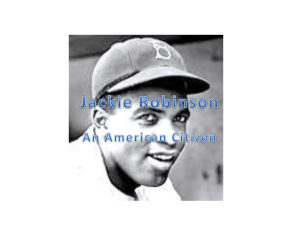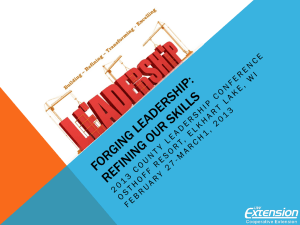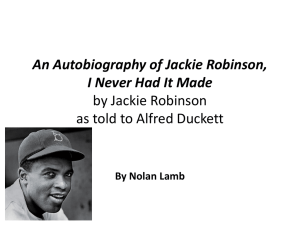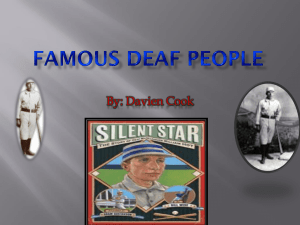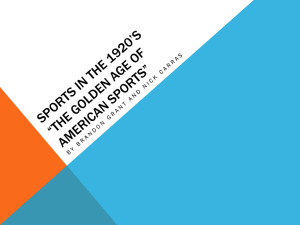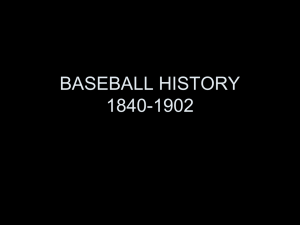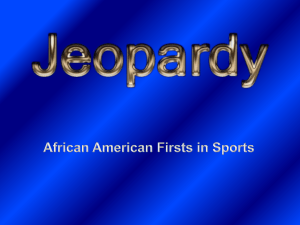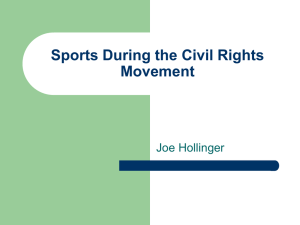Who Desegregated Major League Baseball
advertisement
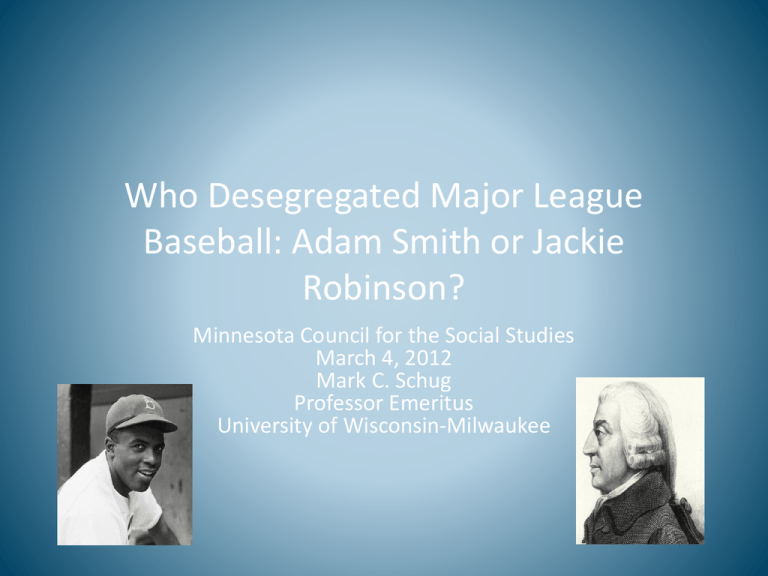
Who Desegregated Major League Baseball: Adam Smith or Jackie Robinson? Minnesota Council for the Social Studies March 4, 2012 Mark C. Schug Professor Emeritus University of Wisconsin-Milwaukee Overview • Problems teaching history • How economic thinking might help • An introduction to the economic way of thinking • Who desegregated Major League Baseball: Adam Smith or Jackie Robinson? • Two side bars • Want more stories like this? Problems Teaching History Problems Teaching U.S. History • Schools rely on U.S. history to teach – Our national identify – An academic understanding of our past • Some states are encouraging teachers to place more emphasis on economics in non-economics courses such as U.S. and World History. • History teaching is criticized as being – Boring in content and pedagogy – Superficial/Trivial – Remote – Rarely focused on “why” Status of State Economics Standards Relationship Between Time in the Curriculum and Learning • Students usually take 6 semesters of U.S. history: – Grade 5: 2 semesters – Grade 8: 2 semesters – Grade 11: 2 semesters • Yet, national tests show that achievement in history is low compared to civics, geography, and economics. NAEP Achievement Levels 36 % below basic 21 % below basic 30 % below basic NAEP Achievement Levels: History 55 % below basic MN K-12 Academic Standards in Social Studies MN K-12 Academic Standards in Social Studies MN K-12 Academic Standards in Social Studies How Economic Thinking Might Help What Can Economics Contribute to Improving the Teaching of History? • Economics stresses the idea that all people make choices. • But, individuals don’t know at the time what the consequences of their choices will be. They Didn’t Know How It Would All Turn Out • In writing history or biography, you must remember that nothing was on track. Things could have gone any way at any point. As soon as you say “was” it seems to fix an event in the past. But nobody ever lived in the past, only the present. • The difference is that it was their present. They were just as alive and full of ambition, fear, hope and all the emotions of life. And, just like us, they didn’t know how it would all turn out. TALKING HISTORY WITH: David McCullough; Immersed in Facts, The Better to Imagine Harry Truman's Life By ESTHER B. FEIN Published: August 12, 1992 New York Times They Didn’t Know How It Would All Turn Out • The challenge is to get the reader [student] beyond the thinking that things had to be the way they turned out and to see the range of possibilities of how it could have been otherwise. Introduction to the Economic Way of Thinking Guide to Economic Reasoning To try and understand why things turned out as they did, we apply the economic way of thinking: 1. People choose. 2. People’s choices involve costs. 3. People respond to incentives in predictable ways. 4. People create economic systems that influence individual choices and incentives. [“Rules of the Game”] 5. People gain when they trade voluntarily. 6. People’s choices sometimes create unintended consequences. Who Desegregated Major League Baseball: Jackie Robinson or Adam Smith? ? Jackie Robinson or Adam Smith? • Branch Rickey, President of the Brooklyn Dodgers, signed Jackie Robinson in 1947 to be the first African American player in the major leagues. • It took courage to make the offer and to sign the contract. • Racial segregation in 1947 was widespread . Racial Discrimination • Jim Crow laws were enacted by several state and local governments as a way to keep African Americans segregated . Racial Discrimination • In the South, nearly every aspect of life was separate including public schools, buses, railroad passenger cars, restrooms, swimming pools, pool halls, and restaurants. Racial Discrimination • The U.S. armed forces were segregated. • In the 1920s, an African American man could not enlist in the U.S. Navy. Supreme Court 1954 • In 1954, the U.S. Supreme Court declared state sponsored school segregation to be unconstitutional. But, Little Changed Right Away • It would take years and additional court decisions before schools and other institutions would take actions regarding desegregation. Why Some and Not Others? • Yet, some industries abandoned racial segregation well before the Civil Rights Act of 1964 and the Voting Rights Act of 1965. • Why might some markets – like major league baseball – move more quickly to reduce racial segregation than others? Jackie Robinson or Adam Smith? • Did Adam Smith’s invisible hand contribute to the desegregation of major league baseball? • What is the metaphor of the invisible hand meant to convey? • Free markets - - allowing people to act in their own self-interest - - promotes positive social outcomes even those these are not intentional. People Choose • MLB club owners - - Branch Rickey in particular - decided to sign African American players because it was the best combination of benefits and costs they could attain. People’s Choices Involve Costs • Questions of cost loomed large. • Before 1947, club owners worried that white fans would stay away if they signed African American players. • They worried that white players would refuse to play with African American players - - fights, strikes. • They worried that revenues would decline. People’s Choices Involve Costs • Robinson endured beanballs, racial epithets, spitting, and spikings. • In 1946, Pee Wee Reese refused to sign a petition by players to boycott playing with a black player. • Reese told the boycott leaders: “I’m not signing that. No way!” People’s Choices Involve Costs • During the first 1947 road trip to Cincinnati, the crowd heckled Robinson during pre-game practice. • Pee Wee Reese, short stop and team captain, placed his arm around Robinson and silenced the crowd. People’s Choices Involve Costs • The NY Times quoted Reese as saying: • “I just wanted to play baseball. I’d just come back from serving in the South Pacific with the Navy in World War II. I had a wife and daughter to support. I needed the money. I just wanted to get on with it.” People Respond to Incentives • What are incentives to owners of MLB clubs? • Earning profits • Winning and all that goes with it People Respond to Incentives • What are incentives to owners of MLB players? • Earning better salaries • Winning and all that goes with it Welcome to Our Baseball Draft Welcome to Our Baseball Draft Mark Schug Right Field Bats .120 40 time: 8.0 FAN APPEAL?? Welcome to Our Baseball Draft Mark Schug Volunteer 1 Right Field Bats .120 40 time: 8.0 FAN APPEAL?? Center Field Bats .180 40 time: 7.8 FAN APPEAL?? Welcome to Our Baseball Draft Mark Schug Volunteer 1 Volunteer 2 Right Field Bats .120 40 time: 8.0 FAN APPEAL?? Center Field Bats .180 40 time: 7.8 FAN APPEAL?? Short Stop Bats .355 40 time: 5.5 FAN APPEAL?? Which Player Would You Draft? • The most productive player! • So, some club owners wanted to hire the best players regardless of race but… • They had an agreement to only sign white players. People Create Economic Systems: The Rules of the Game • Baseball club owners are exempted from federal anti-trust laws. • This was the result of a 1922 Supreme Court ruling in the case of the Federal Baseball Club of Baltimore, Inc. v. National League of Professional Baseball Clubs. People Create Economic Systems: The Rules of the Game • Despite the fact that major league baseball clubs operated a legal cartel, the rules of the game encouraged competition. • Competition erodes the ability of a cartel to enforce the agreements among its members. Remember What Competition Looks Like? Competition from the Negro Leagues • Dozens of African American professional and semiprofessional baseball teams played from 1887 to 1950. • The most successful was the Negro National League founded in 1920 by Rube Foster, who was eventually elected to the Baseball Hall of Fame. Competition from the Negro Leagues • During the 1930s and 1940s a new Negro National League was established; it was regarded as having the most talented players. • In 1946 the West Coast Professional Baseball League was formed in California but only lasted one season. Competition from Barnstormers • Then there were the barnstorming African American teams like the Omaha Tigers and the Miami Giants. • Barnstorming teams traveled circuits in the south or Midwest, for example. Competition: Paige and Dean • The most famous barnstormers were the Satchel Paige All Stars (all African American players) and the Dizzy Dean All Stars (all white players). • They toured the nation every October from 1934 to 1945 and were watched by thousands of fans. Competition to Win In NYC • Competition in big baseball markets like New York City was more intense then it was in smaller baseball markets. • After World War II, New York City had three professional baseball teams - - the Brooklyn Dodgers, the New York Yankees and the New York Giants. Competition to Win in NYC • Fans love to follow winning teams. • Mass transit allowed fans to shift loyalties easily from on club to another. • Having a winning team was one way to attract fans. • Having spectacular players was another. People Gain from Voluntary Trade • In 1946, the Brooklyn Dodgers finished two games behind the Cardinals. • They hoped to do better. • In 1946, Rickey signed Robinson who played that year in the Montreal Royals. • Both sides -- Robinson and Rickey -- expected to gain. • 1947 was the rookie year for Jackie Robinson with the Dodgers. People Gain from Voluntary Trade • Overnight, Robinson became the largest attraction in baseball. • Huge crowds turned out to see him play. • In 1947, the Dodgers won the National League pennant. • They won it again in 1949, 1952, 1953, 1955, and 1956. • The Dodgers won the World Series in 1955. People Gain from Voluntary Trade • Rickey was aware of his overnight success. • He quickly signed more African American players such as Roy Campanella and Don Newcombe. People Gain from Voluntary Trade • Bill Veeck claims that in 1942 he acquired backing to purchase the financially strapped Philadelphia Phillies. • His plan was to hire African American stars from the Negro league. • Commissioner Kenesaw Mountain Landis vetoed the sale and arranged the for National League to take over the club. Side Bar 1 • Veeck is also remembered for his stunts. • In August 19, 1951, when he owned the St. Louis Browns, he sent Eddie Gaedel to the plate. • Eddie was walked on four pitches and then replaced by a pinch runner. • The Browns won the game. 5-3. People Gain from Voluntary Trade • Bill Veeck, later the owner of the Cleveland Indians, signed outfielder Larry Doby who started playing weeks after Robinson in July of 1947. • Veeck also signed the oldest rookie ever signed – Satchel Paige in 1948. • Paige was 42 year s old. People’s Choices Sometimes Create Unintended Consequences • Owners were right to worry about unintended consequences. • Would white fans would stay away? • Would players engage in fights, strikes? • Would revenues would decline? • Fortunately, most often these worries proved to be unfounded. People’s Choices Sometimes Create Unintended Consequences • Rickey may have only intended to field a winning team, win the pennant, and earn a profit. • However, the signing of Robinson desegregated major league baseball. • An unintended consequence of the invisible hand? Other Consequences • Before 1947, were owners right to worry about fans staying away when they signed African American players? • James Gwartney and Charles Haworth found that on average, each additional African American player on a team was associated with between 55,000 and 60,000 additional annual hometeam admissions during the 1950s. Other Consequences • Gwartney and Haworth also found that the number of African American players was a significant factor in determining the number of games won. • For the period from 19501955, they found that the inclusion of an African American player on a major league team, on average, resulted in an additional 3.75 wins per year. Major League Baseball Was Not Alone: Side Bar 2 Southern Street Car Owners • There were other examples of white-owned businesses in the South which tried to hire African American employees or serve African American customers. Street Car Owners Wanted to Earn Profits • Southern street car owners early in the 20th century refused to discriminate against African Americans because discrimination reduced their profits. Hauling Around Empty Space • One manager complained that segregation laws increased costs because the laws required the company to: “haul around a good deal of empty space that is assigned to colored people and not available to both races.” • In Augusta, Savannah, Atlanta, Mobile, and Jacksonville, streetcar companies refused to enforce segregation laws for as long as 15 years after their passage. They Were Right to Worry • African Americans boycotted streetcar lines that obeyed the law and discriminated against them. • Some African Americans formed competing horsedrawn carriage companies. But They Gave Up • But one by one, the companies succumbed as pressure from the government to enforce segregation grew and began to outweigh the costs imposed by the penalty on profits. Conclusions • • • Adam Smith’s invisible hand was a big help to Jackie Robinson and Branch Rickey is ending racial discrimination in major league baseball. Markets make racial discrimination expensive to businesses who are seeking profits. Racial discrimination requires the force of law to sustain it for the long term. Questions Want more stories for teaching economics in American history? Economic Episodes in American History: Wohl Publishing Other Stories • Why Did the British Colonies Succeed Economically—Without Finding Gold and Silver? • Why Did the American Colonists Fight When They Were Safe, Prosperous, and Free? • How Did the U.S. Constitution Provide a Road Map to Economic Prosperity? • Why Fight a War When the North’s Economy Was So Much Stronger? • The Homestead Act of 1862: Was Free Land Really Free? • Did the Comanche and Other American Indians Really Favor Communal Ownership? Other Stories • Were the Robber Barons Robbers or Barons? • Why Did the 19th-Century Monopolies Disappear? • Why Did a Mild Recession in 1929 Become the Great Depression of the 1930s? • Was the New Deal Good for the U.S. Economy? • Why Did the Economy Grow after World War II? • Is the Information Revolution as Big as the Industrial Revolution? • Is free trade out of date? Art History Research The Van Gogh Family • • • • Obnoxious brother Dizzy Aunt Brother who ate prunes Brother who worked at a convenience store • Grandfather from Yugoslavia • • • • Please Gogh Verti Gogh Gotta Gogh Stop N Gogh • U Gogh Art History Research The Van Gogh Family • Cousin from Illinois • Magician uncle • Mexican cousin’s halfbrother • Constipated uncle • Ballroom dancing aunt • Chica Gogh • Wherediddy Gogh • Amee Gogh • Cant Gogh • Tan Gogh Art History Research The Van Gogh Family • Bird lover uncle • Nephew psychoanalyst • Brother who was a Beatle • Flamin Gogh • E Gogh • Rin Gogh Features • 32 chapters focused on an economic episode • Chapter 1 provides an introduction to the economic way of thinking • All other chapters can stand alone • Complete Teacher’s Guide including answer to the Questions for Discussion, correlations to national standards, a teaching activity for each chapter, assessments including constructed response and multiple choice items for each chapter. • Available in multiple formats: print, online, customized How to Order EEAH Phone: (866) 620-6942 Fax: (708) 534-7803 Email: wohlorders@warepak.com Or just click on www.wohlpublishing.com
